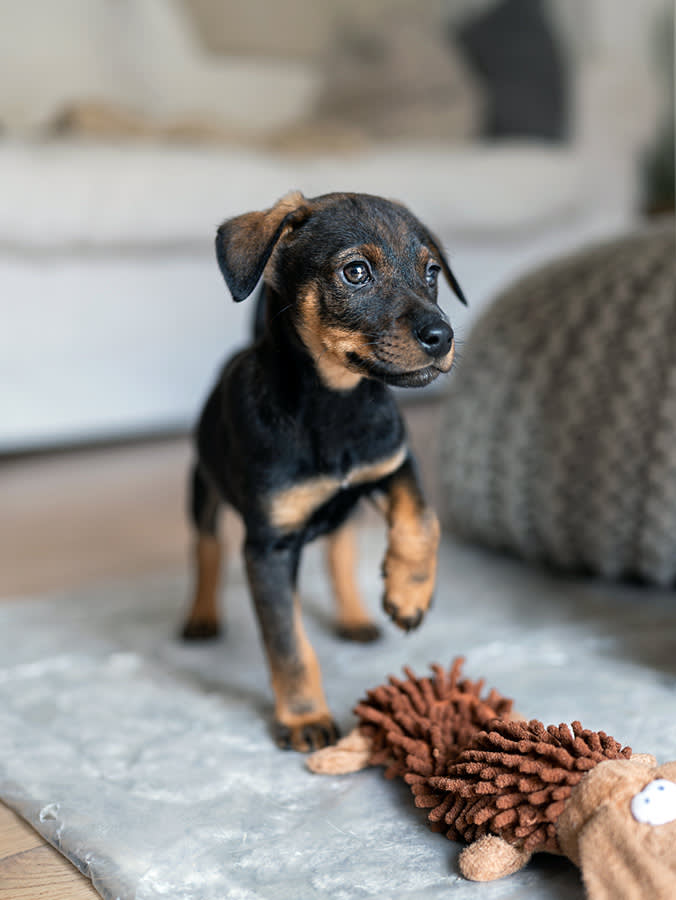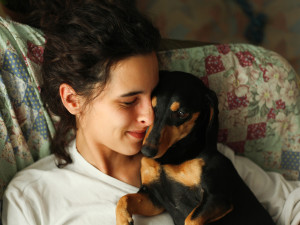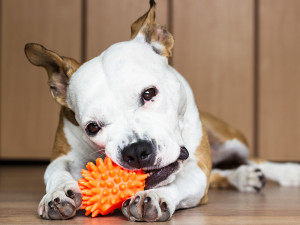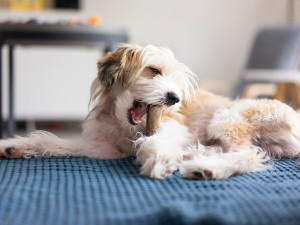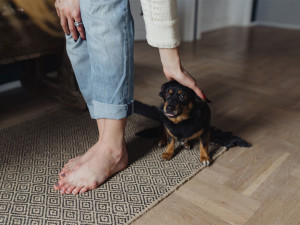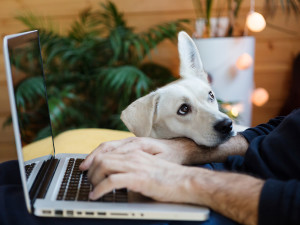Tips for Leaving Your Puppy Home Alone for the First Time
In This Article:
Age-Based Guidelines for Leaving Puppies Alone How to Leave a Puppy Home Alone Can I Leave My Puppy Home Alone for Eight Hours? How to Crate Train a Puppy During the Day Frequently Asked Questions
Leaving your new puppy alone for the very first time will no doubt pull at your heart strings and have you searching for remote work opportunities. But it’s important to remember you can do hard things, and so can your puppy. The key is to be well-prepared and plan ahead so that your first few separations are successful and feel comfortable for you both.
At what age can you leave a puppy home alone?
There is no specific age when it is completely OK or not OK to leave a puppy home alone, and there are a number of factors to consider before leaving your pup solo. The first consideration is their age and stage of development. The more you understand about your puppy’s development, the better you can tailor your training and expectations to what is age-appropriate.
Based on your puppy’s age and weight, you can estimate how often they need to eat, go poop and pee, and exercise. You should not leave your puppy alone long enough to interfere with these needs; this can be both distressing and unhealthy. For example, puppies that are only a few days or weeks old have very specific needs including feedings every few hours, maintaining proper body temperature with heat support, and stimulation to pee and poop.
How much do you spend on your pet per year?
They really cannot be left alone; they require nearly constant monitoring and care. As puppies get older, they can go longer stretches between meals and slowly learn to hold their pee and poop for longer periods of time. This can serve as a rough guide for when you can start to leave your puppy alone and for how long. Typically, this means waiting until your puppy is at least three months old to start some short, gradual separations. How you actually do that involves some planning and preparation.
How to leave a puppy home alone
Introducing the idea of being alone is an important part of training your puppy. You will want your puppy to develop a healthy independence and comfort in being alone, whether you are physically leaving the house, sleeping in separate rooms, or even just simply using the bathroom without a spectator. Here are some ways you can prepare your pup for these experiences:
Practice alone time while you’re home.
It is very important to get in the habit of giving your puppy alone time even when you are home and not constantly carrying them around or smothering them with love (easier said than done, I know). This is a technique you can work on with younger puppies too well before you are ready to leave them home alone.
This may include giving them a safe toy or treat and setting them up to eat it in their own space like a playpen or crate while you leave the room for a few minutes. Encourage your puppy to have their own space and feel comfortable with you stepping away from them. This is a great first step to helping them feel confident when you’re out of sight.
Work on potty training.
While you don’t have to have a completely house-trained puppy before leaving them alone, it is another important step toward their independence. Potty training can take a while for puppies to master, and it’s important to keep in mind the limitations of their age and bladder control.
Very young puppies simply cannot hold their urine for very long, so even if they manage to grasp the concept of house training, they have to be physically large enough to hold it for long periods of time. Knowing this can also help you set a realistic expectation for how long you can leave your puppy alone; you’ll want to be sure to stick to their potty training schedule and not miss a walk.
Set up a comfortable space for your puppy.
Whenever your puppy is unsupervised, it’s important that they are confined to a safe and comfortable space. This is true even when you are home with them but preoccupied with other tasks, as well as when you plan to be out of the house. This is for their safety to ensure they cannot access dangers like toxins or situations that will lead to injury. It is also for their comfort so that they have a reliable routine and a familiar place that feels safe to them.
Puppy-proof the space.
Puppies are notorious for their ability to get into mischief in record time. If you have ever turned around momentarily just to find your puppy doing the unthinkable, you know how quickly it can happen. This is why puppy-proofing is so important. Your puppy needs to have an area that is safe for them to explore and rest when you are not directly supervising them. This may be a crate, playpen, or a specific room that you can close off to keep your puppy safe.
Whatever you decide to use as your puppy’s safe space, be sure to also make an effort to make it feel welcoming and safe to your puppy. Allow them to explore the space on their own and try to do fun things in that space daily, including playtime, treats, or meals. This will help them create a positive association with that space. Never lock them in this space as a punishment as this will create a negative association and can result in fear and anxiety when confined.
Address separation anxiety.
Separation anxiety is a specific condition in dogs characterized by high levels of fear and anxiety when they are left alone. It is not just an occasional problem but a chronic issue for the affected dogs. They have extreme reactions to being left alone that can lead to destructive behaviors, barking or whining nonstop, or peeing or pooping indoors, despite being fully potty trained.
These behaviors are not usually seen in young puppies but develop over time. Often, there is some sort of trauma that leads to this condition, such as moving to a new home, loss of a trusted person, or a major change in their routine and the amount of time they are left alone. However, other times the condition develops without a clear inciting cause. The best ways to prevent separation anxiety are to utilize tools to help your pup be confident, well-socialized, and well-trained. Gradually exposing your puppy to time alone and making it a positive experience is one way to do that. Additionally, having a predictable routine so your dog gets to know when to expect meals, playtime, and their walk schedule can reduce their anxiety.
Finally, ensuring your pup gets plenty of exercise and mental enrichment daily are well-known ways to reduce anxiety. Be sure to build that into your daily routine. For dogs that are already showing signs of separation anxiety, it is important to get professional help right away. This may involve a combination of training techniques, behavior modification, medications, and other solutions aimed at alleviating the most severe symptoms for your pup.
Can I leave my puppy home alone for eight hours?
The short answer is no. Puppies should not be alone for eight hours. From a biological standpoint, they cannot hold their pee or poop that long and they need to eat frequently while they are growing rapidly. Even adult dogs really need a pee break every six hours. From a social-emotional point of view, this is also a very long time for puppies to go without social interactions, exercise, and mental enrichment.
There is a fairly short socialization window in puppy development when they are most amenable to new experiences, animals, and people. In order to be a well-adjusted puppy, they need to maximize exposure to those opportunities every day. A puppy who is alone for many hours is not able to experience the world around them and will be more at risk for behavioral problems as a result. Of course, life happens, and you probably need to work to afford all those new puppy supplies, so there may be days when you have to be out of the house for eight hours or more. This is where all of that crucial prepping and planning comes into play.
If you are planning to adopt a puppy in the near future, try to schedule as much vacation time as you can for those first critical weeks together and minimize your time out of the house. For the days you can’t be home, try to find a friend or family member to hang with your puppy and help them stick to their routine. Depending on where you live, you may also find options like dog walking services or doggie daycares who can walk them, feed them, and even help with basic training.
How to crate train a puppy during the day
Crate training is one common technique used to provide a safe and secure space for puppies to be left alone. When crate training your puppy, it’s important to create a positive association with the crate as a safe space and a place where good things happen. You can do this by encouraging your puppy to play with toys in the crate and by offering treats and food in the crate.
You’ll need to very gradually introduce times where your dog is confined in the crate and use lots of praise and treats when your puppy is calm and quiet in there. At first, you’ll want to have your pup adjust the crate while you are present. Over time, you can gradually move further and further away from the crate and even out of the room. It is important to keep these sessions short.
Try to stop on a positive note when your dog is calm and quiet, as opposed to letting them out when they are barking or whining, which can unintentionally reinforce those behaviors. Eventually, you can start leaving the house for short periods of time while your dog is crated. It may help to set up a camera so you can observe how your dog reacts to being in the crate and to try to return before your dog gets too restless.
Crates are intentionally designed to be on the smaller side, allowing a dog to turn around, stand up, and lay down comfortably but not to be able to do much more than that. This helps to discourage them from peeing and pooping in the crate, because they don’t have enough space to separate from it. For this reason, it is also not meant to be used for very long periods of time.
Many puppies are not able to hold their pee and poop for hours so if they are crated for long periods of time, they will inevitably have an accident. The crate does not allow them to move around or exercise in the ways that puppies need to, so keep their periods of confinement short and set aside plenty of time for play and exercise before and after being crated.
FAQs (People also ask):
How long can you leave a puppy alone at home?
This varies based on their age and needs but in general, puppies should not be left alone for more than a few hours, and they will need to be gradually acclimated to being left alone.
What is the best way to leave a puppy at home alone?
It is very important to have a safe, puppy-proof space prepared for your puppy when they are left alone. This protects them from dangers like toxins and injuries and provides a space where they feel safe and secure.
